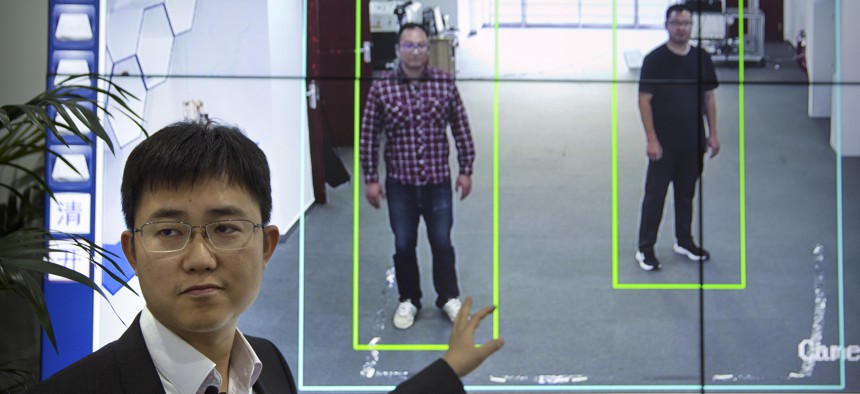
In this Oct. 31, 2018, photo, Huang Yongzhen, CEO of Watrix, demonstrates the use of his firm's gait recognition software at his company's offices in Beijing. AP Photo/Mark Schiefelbein
China’s Rapid AI Development Has Its Limits: Report
Chinese artificial-intelligence researchers are aware of ways their work lags the United States’ — and Beijing is working to fix those.
If China’s leaders start hearing “I’m sorry, Xi, I can’t do that,” it’s probably not because the country’s various artificial-intelligence projects have become sentient. It’s because Chinese scientists and policymakers realize there are obstacles to achieving the government’s ambitious goal of “AI dominance” by 2030.
That’s one contention of a new report from the Center for a New American Security, whose author, Gregory C. Allen, says Chinese scientists and leaders are now aware of ways their research and development programs are lagging those of the United States. Put another way, China is not hurtling past the United States in AI development — yet. For Allen also writes that Beijing is working to remove the obstacles to that goal.
An adjunct senior fellow in CNAS’ Technology and National Security Program, Allen based his report on four trips to Chinese “diplomatic, military, and private-sector” AI conferences, and discussions with industry executives and scientists.
He reports that the Chinese Communist Party and the People’s Liberation Army are keenly interested in — read: pouring money into — research into AI-based surveillance technology and lethal autonomous weapons, even though the latter “runs counter to China’s stated goals of avoiding an AI arms race.”
“China sees military AI R&D as a cheaper and easier path to threatening America’s sources of military power than developing Chinese equivalents of American systems,” Allen writes.
Allen also writes that China sees itself as the U.S.’s peer in AI research and development and commercial AI, and writes that the country has already met its 2020 goal of reaching the “first echelon” of AI globally.
China’s efforts have alarmed various American tech executives, lawmakers, and Trump administration officials. Two years ago, Eric Schmidt, Google’s former executive chairman, predicted: “By 2020, they will have caught up. By 2025, they will be better than us. By 2030, they will dominate the industries.” Last year, Sen. Joni Ernst, R-Iowa, and Sen. Catherine Cortez Masto, D-Nev., introduced a bill to create a committee to “help ensure we stay ahead of countries like China.”
Allen argues in some ways the race may not be that tight. “Though most in China’s leadership agree that China is one of two ‘giants’ in AI, there is a similarly widespread understanding that China is not strong in all areas,” he writes.
Among its weaknesses: hardware and algorithm development, loss of talent, and low technical standards. So China has established educational programs to train and retain top-tier computer scientists, and pursued more patents — for example, in 5G cellular technology. But the loss in innovating AI framework was particularly striking to Allen.
“The absence of Chinese AI companies among the major AI framework developers and open source AI software communities was identified as a noteworthy weakness of China’s AI ecosystem in several of my conversations with executives in China’s technology industry,” Allen writes.
China is attempting to strike a balance between learning from, using, and moving beyond foreign technologies. Allen says this approach is beginning to “bear fruit.” One of the areas where China’s development potential is matching the hype is in AI semiconductors, computer chips that are the foundation for AI innovation — and, he writes, China knows it.
Patrick Tucker contributed to this report.
Related podcast:
NEXT STORY: Pentagon Pushes for Speed in Cloud Strategy



